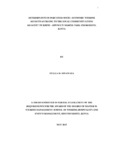Determinants of Perceived Socio - Economic Tourism Benefits Accruing to the Local Community Living Adjacent to Kisite - Mpunguti Marine Park and Reserve, Kenya
Abstract
That socio–economic benefits accruing from tourism in marine protected areas are key to garnering local people’s support and involvement in tourism cannot be overemphasized. Marine protected areas support local communities adjacent them by promoting and supporting their livelihoods. The impacts these areas have on these communities influences their support, attitudes and participation in their conservation. This study assessed determinants of perceived socio–economic tourism benefits accruing to the local community living adjacent to Kisite Mpunguti Marine Park and Reserve (KMMPR). Specific objectives of the study were to determine the effects of demographic characteristics of the local residents’ on perceived socio- economic tourism benefits accruing from KMMPR, to determine the effects of tourism projects supported by KMMPR on the perceived socioeconomic benefits accruing to the local community, to establish the effect of local people’s participation in tourism activities supported by KMMPR on their perception about tourism benefits accrued and to establish the effect of government policies on local community’s perception about socio-economic tourism benefits accruing from KMMPR. The study utilized the survey research design. The target population was the local community living adjacent to the park and Reserve and staff from Kenya Wildlife Service and the sample was randomly selected. Primary data was collected using questionnaires while secondary data was sourced from published and unpublished sources like books and journals. Data was analyzed descriptively using frequencies and percentages while correlation and multiple regression analysis were done to determine associations among selected variables. Results showed that, initiated tourism projects, government policy, and participation levels of individuals within the community had a positive effect on perceived socioeconomic tourism benefits accruing from KMMPR, while demographic characteristics had an inverse relationship. The F test results indicated that all the foregoing independent variables showed a significant relationship with perceived socio-economic benefits among local communities living adjacent to KMMPR. Results also showed that there was a direct association between determinants of perceived socio- economic tourism benefits among the locals. Compensating the local community for foregoing their traditional livelihoods through creation of employment opportunities and empowering them financially to start their own tourism related businesses will make communities view tourism in KMMPR as a tool for promoting their welfare in return for losses caused by foregoing traditional livelihoods activities. KWS should create public awareness through conservation education to sensitize the local community on the invaluable role of MPAs and the need to conserve them. This will reduce conflicts between local residents and KMMPR management. Local residents should also be facilitated to have access to low interest credit facilities to establish tourism related businesses.

